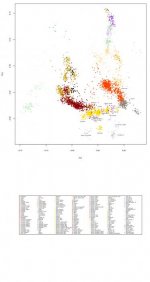If I am wrong and the Italics were like those individuals in the North, and Rome was founded by Italic Latin and influenced by immigrants from Etruscan region, you are talking about massive amounts of Greeks moving to Rome to start a new life, in the Republican period too. Rome became a 1 million from those from Greek descent moving to Central Italy (also many Eastern Med people too). Central Italy today still mirrors Southern Italy, which mirrors Greece and Sicily. Campania and Latium have nearly identical haplogroup %s.
If Italic samples are close to Sardinia and Etruscans (closer to Sardinia), then I very well could be right in the Italics were the natives from the neolithic era. Which clearly opens up the Germanic language not as the combination of celt and slav, but a different language of I1s. This theory is independently supported for now in the existence of the Saxons who were 2/3s I1/I2 (pre-Pipins), according to one study.
Very interesting developments.
Northern Italy during the celtic invasions looks like a repeat of Spain, with neolithic women shacked up with new comers from Yamnaya.
The continuing saga of this:
https://www.dailymail.co.uk/science...n-descended-just-trio-Bronze-Age-leaders.html
The disappearance of the men, with some women remaining.






